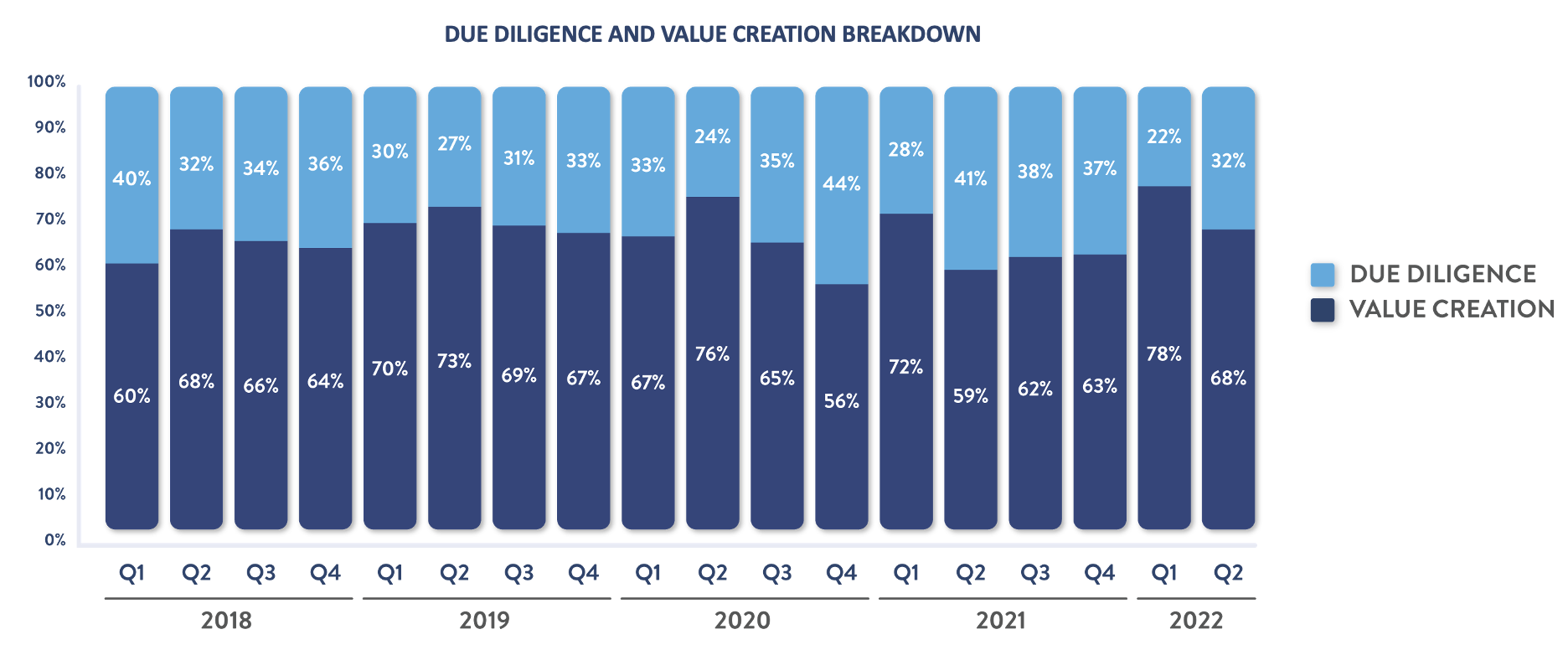Customer Type: PE-Backed Companies
In the Know: Positioning for Growth in a Recession
We’re sharing real-time trending topics we are hearing from our 500+ PE firm clients as we combat ongoing recessionary and inflationary pressures. One of our Private Equity Strategic Account Executives, Cydney Dicken, talks about why and how leading PE firms are taking action to increase their portfolio’s equity value during these uncertain times.
Learn more about what PE firms are doing as they prepare to run towards the storm by watching the video below.
Interested in addressing competitive opportunities, optimizing profitability, or recruiting and retaining the right talent? Contact us here. You can also learn more about the specific ways we drive value for PE firms by connecting them to the exact-fit resources they need by reading our case studies.
Q2 2022 BluWave Insights
Every quarter our team analyzes the projects we work on with our 500+ PE firm clients to get a birdseye view of the market. You can request your copy here to view all of the trends that we have seen over the past quarter.
Key findings from Q2 include value creation remaining strong due to the record number of deals made at robust valuation multiples during 2021, inflation continuing to wreak havoc on global economies, and the recessionary pressures availing substantial opportunities for all of the best business builders.
Learn more about the insights we gleaned from the report by watching the video below.
To request the full the report, click here.
Video transcript:
BluWave has a unique vantage in the North American economy. While working with more than 500 of the world’s top business builders, we’re able to understand unique insights into how and why the best business builders in the world are assessing opportunities and building value in their portfolio companies. Here are some of the unique insights we generated during Q2 2022. The name of the game in the second quarter was value creation. Value creation accounted for 68% of all activity funneled through the BluWave engine. Value creation was so robust during this last quarter for a number of reasons. Number one, private equity firms invested in a large number of companies last year so they’re acting on those investments to begin transformation. Number two, deal flow is down. A lot of the best companies were sold last year. Other companies are pausing their ambitions as the economic cycle is softening and the results slow in kind. The other mega trend that is readily apparent in our data is the specter of inflation. The private equity industry is not resting on its laurels. It’s taking aggressive action to raise prices, reduce costs, and bring in the right people with the right skills for the current times. It’s our hope that the data and insights we’re sharing will help you build your business with more speed and certainty. If you’d like to learn more and get the full report, please contact any member of the BluWave team or follow a link below.
Ecommerce company hacked, operations shut down, critically needed support
Cyber breach led to urgent need for cybersecurity expert for portco
A private equity-backed ecommerce company suffered a cyber breach shutting down all operations. They urgently needed a cybersecurity expert that could assess the situation and remediate the breach in order to restart operations. At the time of outreach, the company did not know how or why the breach occurred, or the scope of the problem, but needed to restart operations immediately to serve their customers.
BluWave identified pre-vetted experts that met the client’s specific needs
The client reached out to BluWave on Friday afternoon shortly after the breach was discovered indicating their urgent need for assessment and action. BluWave has a deep network of cybersecurity specialists. We quickly interviewed the client to understand their specific needs and identified the select few cybersecurity providers that met their exacting requirements.
Client was connected to top expert within minutes
Within 15 minutes of scoping the client’s needs, BluWave put the company in contact with a best-in-class cybersecurity firm. The cybersecurity firm immediately sprung into action and began supporting the company on the same day that the breach occurred.
Pricing Strategy Expert Needed To Lift Revenue
Critical need for pricing strategy expert for B2C company
A PE-backed B2C company came to us with a critical need for a pricing strategy expert to maximize revenue. Since competing against big-box retailers, the company realized their need to set pricing that clearly conveyed the value of their offerings to their price-conscious and value-driven consumers. They set this objective as a top priority and urgently needed a PE-grade pricing strategy expert that had experience in the consumer products industry and could set a pricing and promotion strategy to maximize response rates and demand.
BluWave has in-network experts to connect with client
The client reached out to BluWave and within several hours, we interviewed the company to understand the details & nuances of their need. BluWave utilizes technology, data, and human ingenuity to pre-map assess, monitor, and maintain deep pools of best-in-class pricing strategy experts. Mapping the specifics of the company’s need to our marketplace of third-party resources, we identified two exact-fit pricing strategy experts for the client.
Company engages expert to maximize revenue
Quickly after the initial scoping call, the company was introduced to two PE-grade pricing strategy experts that specialized in the consumer products industry. The client selected their ideal choice. The B2C company was able to confidently drive an excellent outcome without wasting time and the client was able to quickly achieve its objective of maximizing response rates and demand through strategic pricing and an aggressive seasonal promotional schedule.
Vital Procurement Consulting Group for Supply Chain Issues
Manufacturing company in need of procurement consulting group
A food & beverage manufacturing company needed a procurement consulting group that could generate input cost savings. Having been recently acquired they needed a resource to develop and implement a sophisticated purchasing and procurement strategy for them. With COVID and inflation leading to supply chain issues and fluctuating prices on their raw materials, they urgently needed a procurement expert with experience in this specific section of the food and beverage raw materials market that could dig into the numbers and create a tactical plan.
BluWave identifies exact-fit provider meeting company-specific criteria
The client reached out to BluWave and within several hours, we interviewed the company to understand the details & nuances of their need. BluWave utilizes technology, data, and human ingenuity to pre-map assess, monitor, and maintain deep pools of best-in-class procurement consulting groups. Mapping the specifics of the company’s need to our network of third-party resources, we identified an exact-fit procurement consulting group for the client.
Company selects procurement consulting group, combatting supply chain issues
Quickly after the initial scoping call, we introduced the company to the exact-fit, pre-vetted service provider from our Intelligent Network that we had identified met their exacting criteria. The client confidently engaged the provider and they quickly helped the client get their procurement strategy on track while also cutting unnecessary costs in the supply chain.
Commercial due diligence needed to aid growth strategy
Commercial due diligence needed for growth strategy
A services company came to us with an urgent need for an individual or group that could perform commercial due diligence in order to help them better understand growth opportunities. With their eye on expanding into an adjacent market, the company was in need of a service provider that could help them better understand the size of the total addressable market, current penetration of the market, market trends, and more. In addition to understanding this information, they were looking for a provider that could help them put it into action and determine how to attack this new potential market.
BluWave leverages network to identify exact-fit diligence providers
The client reached out to BluWave and within several hours, we interviewed the company to understand the details & nuances of their need. BluWave utilizes technology, data, and human ingenuity to pre-map assess, monitor, and maintain deep pools of best-in-class commercial due diligence providers. Mapping the specifics of the company’s need to our network of third-party resources, we identified 3 exact-fit commercial due diligence providers for the client.
Client selected ideal provider to drive growth
Quickly after the initial scoping call, we introduced the company to the two exact-fit, pre-vetted service providers from our Business Builders’ Network that we had identified met their exacting criteria. The client selected their ideal choice and was able to quickly engage the provider to conduct the research they needed and start putting a well-developed growth strategy into place.
Critical salesforce effectiveness training firm
Medical supplier has critical need to assess salesforce team and GTM strategy
A PE-backed medical supplier company came to us with a prompt need to assess their existing salesforce team and go-to-market strategy. The company’s sales team was struggling with a high turnover rate and they urgently needed to fix this, examine how to get the right team members in place, and determine how to keep them in place. They were also in need of a new GTM strategy that the salesforce could execute on once they had onboarded the right team members.
BluWave quickly identifies PE-grade providers
The company reached out to BluWave and within several hours, we interviewed them to understand the details & nuances of their need. BluWave utilizes technology, data, and human ingenuity to pre-map assess, monitor, and maintain deep pools of best-in-class salesforce effectiveness experts. Mapping the specifics of the company’s need to our Business Builders’ Network of third-party resources, we identified an exact-fit salesforce effectiveness and training firm for the client.
Company moves forward with exact-fit provider
On the same day that they initially reached out, the company was introduced to the exact-fit salesforce effectiveness and training firm that we identified in our Business Builders’ Network. The company immediately engaged the group and was able to start the project within 24 hours.
Voice of Customer Research Critical for Add-On Acquisition
Local Voice of Customer research provider needed for acquisition evaluation
An IT staffing company came to us with a critical need for Voice of Customer research to be done on an add-on acquisition target they were evaluating. Looking to grow their company via this acquisition, they were interested in engaging a provider that could conduct interviews with 7 clients of the target add-on. The company needed a Voice of Customer provider that could work within their budget, complete the 7 interviews, and conduct the work in Toronto where the target add-on and their clients were located.
Client contacted BluWave to identify PE-grade provider
The client reached out to BluWave on a Wednesday morning and within several hours, we interviewed the company to understand the details & nuances of their need. BluWave utilizes technology, data, and human ingenuity to pre-map assess, monitor, and maintain deep pools of best-in-class Voice of Customer providers. Mapping the specifics of the company’s need to our marketplace of third-party resources, we identified 2 exact-fit Voice of Customer providers for the client.
Utilizing our extensive network, BluWave introduced two pre-vetted providers
On the same day that the company initially reached out, we introduced them to the two exact-fit, pre-vetted service providers that we had identified met their exacting criteria. The client selected their ideal choice and was able to quickly engage the provider to conduct the research they needed in order to determine whether or not to move forward with the add-on acquisition.
Activating AI: Empowering Your Business for Success
Imperative Sales Force Effectiveness and GTM Strategy Needed
PE firm urgently needs to assess effectiveness of sales team at healthcare portco
A middle-market PE firm Partner came to us with a prompt need to assess the existing sales team and go-to-market strategy at one of their portfolio companies that provides medical equipment and asset management services to the healthcare industry. The founder-owned portco was struggling with a high turnover rate and urgently needed to examine how to get the right sales team members in place. They were also in need of a new GTM strategy that they could execute once they had the right team in place. Having previously completed Voice of Customer (VoC) work, portco leadership was ready to take the next step.
BluWave identifies PE-grade consulting firms specific to the firm’s needs
Leveraging our founder’s 20 years in private equity, we have extensive frameworks for assessing PE-grade sales effectiveness and GTM strategy needs. BluWave utilizes technology, data, and human ingenuity to pre-map, assess, monitor, and maintain deep pools of sales and GTM strategists that uniquely meet the private equity standard. We interviewed the PE firm to understand their specific key criteria, and then connected the client with the select pre-vetted consulting firms from our invitation-only Business Builder’s Network that fit their exacting needs.
Firm engages with presented provider and moves forward to improve portco strategy
Within the same day of reaching out, the PE firm was introduced to a specialized sales effectiveness & training firm with additional experience developing GTM strategies for PE-backed companies. The client immediately engaged with this group and was able to start the project within 24 hours. The service provider we connected them with began by assessing the current sales processes and team members within the portco’s two verticals and then worked with them on developing an improved strategy.
In The Know: Executive Search
As part of an ongoing series, we’re sharing real-time trending topics we are hearing from our 500+ PE firm clients. In our most recent installment, we discuss why leading PE firms are choosing to engage specialized executive search firms over larger generalist recruiting firms.
Learn more by watching the video below.
Interested in connecting with a specialized recruiter or any other type of third party? Contact us here. You can also learn more about the specific ways we drive value for PE firms by connecting them to the exact-fit resources they need by reading our case studies.










